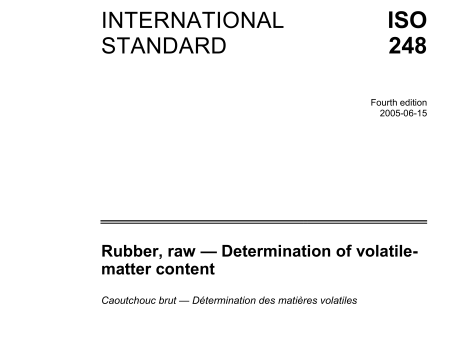ISO 248 pdf download – Rubber, raw -Determination of volatile-matter content.
3.1 Hot-mill method
A test portion is sheeted out on a heated mill until all volatile matter is driven off. The loss in mass during
milling Is calculated and expressed as volatile-matter content.
3.2 Oven method
When the sample is not in powder form, a piece is homogenized in accordance with ISO 1795 using a laboratory mill, A test portion, taken either from the commanuted piece or darectly from the rubber if In powdered form, is sheeted out and dried in an oven to constant mass The volatile-matter content is calculated as the mass lost during this procedure, together with the mass lost during any homogenization of the piece.
4 Hot-mill method
4.1 Apparatus
4.1.1 Mlxln9 mill, complying with the requirements of ISO 2393.
4.2 Procedure
4.2.1 Hot-mill method A
42.1.1 Sheet out a test piece of about 250 g in accordance with ISO 1795. Weigh to the nearest 0.1 g before and after homogenization (masses ,,i. and in2 respectively).
42.1.2 Adjust the clearance of the mill rolls to 0.25mm ± 0.05 mm, using lead strips as specified I, ISO 2393. MaintaIn the surface temperature of the rolls at 105 °C ± 5°C.
4.2.1.3 Pass a weighed test portion (mass in3) repeatedly through the mill (4.1.1) for 4 mm. Do not allow
the test portion to band and take care to prevent any loss of rubber. Weigh the test portion to the nearest 0.1 g.
Pass the test portion through the mill for an additional 2 mm and reweigh. If the masses at the end of the
4 mm and 6 mm periods differ by less than 0.1 g. calculate the volatile-matter content.
If not continue passing the test portion through the mid for 2 ml, periods until the mass does not decrease by more than 0,1 g between successive weighings (final mass ,n4). Before each weighing, allow the rubber to cool to room temperature in a desiocator.
4.2.1.4 When the rubber Is flaky or becomes sticky in the m roil, making weighing difficult or impossible, the oven method (prooedts’e 5.2.1.2) shall be used.
4.2.2 Hot-mill method B
Sheet out a test piece of about 250 g and weigh to the nearest 0,1 g (mass in5). Adjust the surface temperature of the mill roll to 105°C ± S.C and the clearanceof the mdl roll to 0,25mm t 0.05 mm. Pass the test piece through the mill not less than twice, then reweigh to the nearest 0,1 g, followed by passing through the mill not less than twice again and reweighing. When the mass difference before and after roll passing is less than 0.1 g. the test piece Is considered to be well dned. If it is not well dried, continue passing the test piece twice through the roll until the mass difference is less than 0.1 g (final mass ‘a6).
NOTE Although moisture does not affect the result. oooling in a desiccator before weighng is desirable
5.2.1.2.3 When sheeting is impossible, take a log test portion from the homogenized piece and cut it by hand lilo small cubes with edges of approximately 2 mm. Place the cubes on a watch-glass or an aluminium tray to facilitate weighing. Weigh to the nearest 1 mg (mass ,n).
5.2.1.2.4 Aitematively, when the rubber is In powdered form, select a test portion of about lOg taken at random and place it on a watch-glass or an aluminium tray to facilitate weighing. Weigh to the nearest 1 mg (mass ing).
5.2.1.3 Oven treatment (natural and synthetic rubbers)
Place the test portion. derived in accordance with either 5,2.1,1 or 5.2.1.2, for 1 h in the oven (5.1.1), maintained at 105 C + 5 ‘C, with the ventilators open and with the circulating fan, if fitted, switched on. Arrange the rubber so as to present the Largest possible surface area to the hot air. Allow to cool in a desiccator, and weigh. Repeat the heating for further 30 mm penods until the mass does not decrease by more than 1 mg between successive weighing (final mass in10),
5.2.2 Oven method B
51.2.1 WeIgh a sample of about 250 g and pass It through the mill roll, whose surface temperati.we is adjusted to about 30 ‘C and the roll clearance to 0.25 mm ± 0.05 mm. to get thin sheet, Sample randomly two test pieces of about SOg from this sheet and weigh the mass to the nearest 10mg (mass intl)
5.2.2.2 When this sheeting is impossible due to the sample sticking to the rot take two test pieces of about lOg directly from the sample. Follow by cutting them into small cubes of about 2 mm size. Place them Ii a tared aluminium tray of 15mm depth and 60mm diameter or in a tray with similar shape and weigh the mass to the nearest I mg (mass in11). Place the tray containing the samples m an oven maintained at 105 ‘Ct 5 C for I h. Remove the tray from the oven and cool in a desiccator to room temperature Reweigh the mass (mass 12).
ISO 248 pdf download – Rubber, raw -Determination of volatile-matter content
